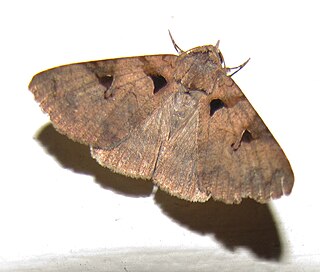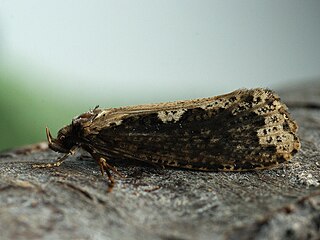Clay is a material primarily composed of a grouping of clay minerals, and can be used as an art medium.

The Herminiinae are a subfamily of moths in the family Erebidae. The members of the subfamily are called litter moths because the caterpillars of most members feed on dead leaves of plants, though others feed on living leaves, and/or the mushrooms of fungi as in the case of genus Idia (moth).

Hypena is a genus of moths in the family Erebidae. It was first described by Franz von Paula Schrank in 1802. These non-migratory moths overwinter as pupae and almost never estivate as adults.
Godasa is a monotypic moth genus of the family Noctuidae erected by Francis Walker in 1865. Its only species, Godasa sidae, was first described by Johan Christian Fabricius in 1794. It is found in Cameroon, the Democratic Republic of the Congo, Equatorial Guinea, the Gambia, Ghana, Guinea, Madagascar, Nigeria, Sierra Leone and Tanzania.

Paracolax is a genus of litter moths of the family Erebidae. The genus was erected by Jacob Hübner in 1825.

Avatha discolor is a species of moth of the family Erebidae. It is found from the Indo-Australian and Pacific tropics to as far east as Henderson Island.

Prochoreutis myllerana, Miller’s nettle-tap or small metal-mark, is a moth of the family Choreutidae found in Asia and Europe. Miller's nettle-tap was first described by Johan Christian Fabricius in 1794 from a specimen found in Sweden.

Oraesia emarginata is a species of moth of the family Erebidae first described by Johan Christian Fabricius in 1794. It is found in Australia, New Caledonia, Indonesia, New Guinea, Pakistan, the Philippines, India, Sri Lanka, Sulawesi, Taiwan, China, Japan, Korea and Nepal as well as Eritrea, Ethiopia, Kenya, Namibia, Nigeria, South Africa, Tanzania, the Gambia, Uganda, Oman and Yemen.
Calyciphora albodactylus is a moth of the family Pterophoridae. It is found in most of Europe, except Portugal, the Benelux, Great Britain and Ireland. It is also known from Russia and Anatolia. The species was first described by Johan Christian Fabricius in 1794.

Amyna punctum is a moth of the family Noctuidae first described by Johan Christian Fabricius in 1794. This moth can be found throughout subtropical African countries such as South Africa, Madagascar and Australasian countries like India, Sri Lanka, the Philippines, Borneo and the Andaman Islands.
Scopula umbilicata, the swag-lined wave moth, is a moth of the family Geometridae. The species was first described by Johan Christian Fabricius in 1794. It is found from the southern part of the United States to South America and the West Indies.

Synchlora herbaria is a moth in the family Geometridae first described by Johan Christian Fabricius in 1794. It is found in Florida, Cuba, Hispaniola, Puerto Rico, the Bahamas, Antigua, Dominica and the Virgin Islands.

Epipagis tristalis is a small moth in the family Crambidae that is found in Papua New Guinea. It was described by George Hamilton Kenrick in 1907 based on insects collected by Antwerp Edgar Pratt. Pratt wrote Two Years among New Guinea Cannibals based on his time there.

Haplotinea insectella, the drab clothes moth or fungus grain moth, is a moth of the family Tineidae. It was described by Johan Christian Fabricius in 1794. It is found in all of Europe, except Ireland, the Iberian Peninsula and the western and southern part of the Balkan Peninsula. It is also found in North America. The species is often found in warehouses, granaries, mills and farm buildings.
Achyra bifidalis is a moth in the family Crambidae. It was described by Johan Christian Fabricius in 1794. It is found from the southern United States south through Mexico to Brazil and Argentina. It is also found in the West Indies.

Eriopygodes imbecilla, the Silurian, is a moth of the family Noctuidae first described by Johan Christian Fabricius in 1794.

Acontia marmoralis is a moth of the family Noctuidae first described by Johan Christian Fabricius in 1794. It is found in Sri Lanka, India, Japan and Taiwan.

Strophedra nitidana is a moth belonging to the family Tortricidae first described by Johan Christian Fabricius in 1794.

Scardia boletella is a moth, belonging to the family Tineidae. The species was first described by Johan Christian Fabricius in 1794.















